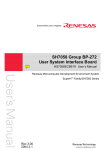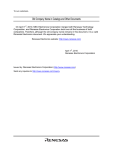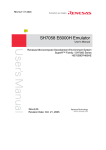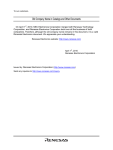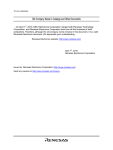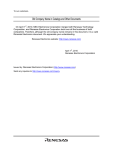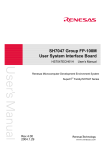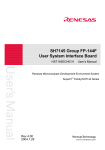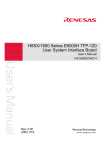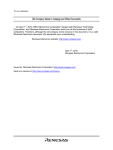Download Renesas FP-256H Technical information
Transcript
To our customers, Old Company Name in Catalogs and Other Documents On April 1st, 2010, NEC Electronics Corporation merged with Renesas Technology Corporation, and Renesas Electronics Corporation took over all the business of both companies. Therefore, although the old company name remains in this document, it is a valid Renesas Electronics document. We appreciate your understanding. Renesas Electronics website: http://www.renesas.com April 1st, 2010 Renesas Electronics Corporation Issued by: Renesas Electronics Corporation (http://www.renesas.com) Send any inquiries to http://www.renesas.com/inquiry. Notice 1. 2. 3. 4. 5. 6. 7. All information included in this document is current as of the date this document is issued. Such information, however, is subject to change without any prior notice. Before purchasing or using any Renesas Electronics products listed herein, please confirm the latest product information with a Renesas Electronics sales office. Also, please pay regular and careful attention to additional and different information to be disclosed by Renesas Electronics such as that disclosed through our website. Renesas Electronics does not assume any liability for infringement of patents, copyrights, or other intellectual property rights of third parties by or arising from the use of Renesas Electronics products or technical information described in this document. No license, express, implied or otherwise, is granted hereby under any patents, copyrights or other intellectual property rights of Renesas Electronics or others. You should not alter, modify, copy, or otherwise misappropriate any Renesas Electronics product, whether in whole or in part. Descriptions of circuits, software and other related information in this document are provided only to illustrate the operation of semiconductor products and application examples. You are fully responsible for the incorporation of these circuits, software, and information in the design of your equipment. Renesas Electronics assumes no responsibility for any losses incurred by you or third parties arising from the use of these circuits, software, or information. When exporting the products or technology described in this document, you should comply with the applicable export control laws and regulations and follow the procedures required by such laws and regulations. You should not use Renesas Electronics products or the technology described in this document for any purpose relating to military applications or use by the military, including but not limited to the development of weapons of mass destruction. Renesas Electronics products and technology may not be used for or incorporated into any products or systems whose manufacture, use, or sale is prohibited under any applicable domestic or foreign laws or regulations. Renesas Electronics has used reasonable care in preparing the information included in this document, but Renesas Electronics does not warrant that such information is error free. Renesas Electronics assumes no liability whatsoever for any damages incurred by you resulting from errors in or omissions from the information included herein. Renesas Electronics products are classified according to the following three quality grades: “Standard”, “High Quality”, and “Specific”. The recommended applications for each Renesas Electronics product depends on the product’s quality grade, as indicated below. You must check the quality grade of each Renesas Electronics product before using it in a particular application. You may not use any Renesas Electronics product for any application categorized as “Specific” without the prior written consent of Renesas Electronics. Further, you may not use any Renesas Electronics product for any application for which it is not intended without the prior written consent of Renesas Electronics. Renesas Electronics shall not be in any way liable for any damages or losses incurred by you or third parties arising from the use of any Renesas Electronics product for an application categorized as “Specific” or for which the product is not intended where you have failed to obtain the prior written consent of Renesas Electronics. The quality grade of each Renesas Electronics product is “Standard” unless otherwise expressly specified in a Renesas Electronics data sheets or data books, etc. “Standard”: 8. 9. 10. 11. 12. Computers; office equipment; communications equipment; test and measurement equipment; audio and visual equipment; home electronic appliances; machine tools; personal electronic equipment; and industrial robots. “High Quality”: Transportation equipment (automobiles, trains, ships, etc.); traffic control systems; anti-disaster systems; anticrime systems; safety equipment; and medical equipment not specifically designed for life support. “Specific”: Aircraft; aerospace equipment; submersible repeaters; nuclear reactor control systems; medical equipment or systems for life support (e.g. artificial life support devices or systems), surgical implantations, or healthcare intervention (e.g. excision, etc.), and any other applications or purposes that pose a direct threat to human life. You should use the Renesas Electronics products described in this document within the range specified by Renesas Electronics, especially with respect to the maximum rating, operating supply voltage range, movement power voltage range, heat radiation characteristics, installation and other product characteristics. Renesas Electronics shall have no liability for malfunctions or damages arising out of the use of Renesas Electronics products beyond such specified ranges. Although Renesas Electronics endeavors to improve the quality and reliability of its products, semiconductor products have specific characteristics such as the occurrence of failure at a certain rate and malfunctions under certain use conditions. Further, Renesas Electronics products are not subject to radiation resistance design. Please be sure to implement safety measures to guard them against the possibility of physical injury, and injury or damage caused by fire in the event of the failure of a Renesas Electronics product, such as safety design for hardware and software including but not limited to redundancy, fire control and malfunction prevention, appropriate treatment for aging degradation or any other appropriate measures. Because the evaluation of microcomputer software alone is very difficult, please evaluate the safety of the final products or system manufactured by you. Please contact a Renesas Electronics sales office for details as to environmental matters such as the environmental compatibility of each Renesas Electronics product. Please use Renesas Electronics products in compliance with all applicable laws and regulations that regulate the inclusion or use of controlled substances, including without limitation, the EU RoHS Directive. Renesas Electronics assumes no liability for damages or losses occurring as a result of your noncompliance with applicable laws and regulations. This document may not be reproduced or duplicated, in any form, in whole or in part, without prior written consent of Renesas Electronics. Please contact a Renesas Electronics sales office if you have any questions regarding the information contained in this document or Renesas Electronics products, or if you have any other inquiries. (Note 1) “Renesas Electronics” as used in this document means Renesas Electronics Corporation and also includes its majorityowned subsidiaries. (Note 2) “Renesas Electronics product(s)” means any product developed or manufactured by or for Renesas Electronics. User’s Manual SH7058 Group FP-256H User System Interface Board HS7058ECF61H User’s Manual Renesas Microcomputer Development Environment System SuperH™ Family/SH7050 Series Rev.6.0 2004.01 Cautions Keep safety first in your circuit designs! 1. Renesas Technology Corp. puts the maximum effort into making semiconductor products better and more reliable, but there is always the possibility that trouble may occur with them. Trouble with semiconductors may lead to personal injury, fire or property damage. Remember to give due consideration to safety when making your circuit designs, with appropriate measures such as (i) placement of substitutive, auxiliary circuits, (ii) use of nonflammable material or (iii) prevention against any malfunction or mishap. Notes regarding these materials 1. These materials are intended as a reference to assist our customers in the selection of the Renesas Technology Corp. product best suited to the customer's application; they do not convey any license under any intellectual property rights, or any other rights, belonging to Renesas Technology Corp. or a third party. 2. Renesas Technology Corp. assumes no responsibility for any damage, or infringement of any third-party's rights, originating in the use of any product data, diagrams, charts, programs, algorithms, or circuit application examples contained in these materials. 3. All information contained in these materials, including product data, diagrams, charts, programs and algorithms represents information on products at the time of publication of these materials, and are subject to change by Renesas Technology Corp. without notice due to product improvements or other reasons. It is therefore recommended that customers contact Renesas Technology Corp. or an authorized Renesas Technology Corp. product distributor for the latest product information before purchasing a product listed herein. The information described here may contain technical inaccuracies or typographical errors. Renesas Technology Corp. assumes no responsibility for any damage, liability, or other loss rising from these inaccuracies or errors. Please also pay attention to information published by Renesas Technology Corp. by various means, including the Renesas Technology Corp. Semiconductor home page (http://www.renesas.com). 4. When using any or all of the information contained in these materials, including product data, diagrams, charts, programs, and algorithms, please be sure to evaluate all information as a total system before making a final decision on the applicability of the information and products. Renesas Technology Corp. assumes no responsibility for any damage, liability or other loss resulting from the information contained herein. 5. Renesas Technology Corp. semiconductors are not designed or manufactured for use in a device or system that is used under circumstances in which human life is potentially at stake. Please contact Renesas Technology Corp. or an authorized Renesas Technology Corp. product distributor when considering the use of a product contained herein for any specific purposes, such as apparatus or systems for transportation, vehicular, medical, aerospace, nuclear, or undersea repeater use. 6. The prior written approval of Renesas Technology Corp. is necessary to reprint or reproduce in whole or in part these materials. 7. If these products or technologies are subject to the Japanese export control restrictions, they must be exported under a license from the Japanese government and cannot be imported into a country other than the approved destination. Any diversion or reexport contrary to the export control laws and regulations of Japan and/or the country of destination is prohibited. 8. Please contact Renesas Technology Corp. for further details on these materials or the products contained therein. Preface The HS7058ECF61H is a user system interface board that connects a user system for the SH7058 FP-256H package to the SH7058 E6000H emulator (HS7058EPH60H). i Contents Section 1 Configuration.....................................................................................1 Section 2 Connection Procedures ......................................................................3 2.1 2.2 2.3 2.4 2.5 2.6 Connecting User System Interface Board to User System ................................................ 3 2.1.1 Installing IC Socket.............................................................................................. 3 2.1.2 Installing IC Socket Connector ............................................................................ 4 2.1.3 Fastening IC Socket Connector............................................................................ 5 Exchanging the Spacer of the EV-Chip Board.................................................................. 6 Connecting User System Interface Board to EV-Chip Board ........................................... 7 Recommended Dimensions for User System Mount Pad (Footprint) ............................... 9 Dimensions for EV-Chip Board and User System Interface Board................................... 10 Resulting Dimensions after Connecting User System Interface Board ............................. 11 Section 3 Verifying Operation...........................................................................12 Section 4 Notice.................................................................................................14 ii Section 1 Configuration Figure 1 and table 1 show the configuration and components of the user system interface board for the FP-256H package. Please make sure you have all of these components when unpacking. EV-chip board Spacer Board Screw M3 × 5 mm IC socket connector IC socket User system Figure 1 User System Interface Board for the SH7058 FP-256H Package 1 CAUTION Use a TQPACK256RD socket and a TQSOCKET256RDP (manufactured by Tokyo Eletech Corporation) for the FP-256H package IC socket and IC socket connector on the user system. Table 1 HS7058ECF61H Components No. Component Quantity 1 Board 1 2 IC socket 1 For the FP-256H package (to be mounted on the user system) 3 IC socket connector 1 For the FP-256H package (for connecting the IC socket and the user system interface board) 4 Screw (M3 x 5 mm) 1 For fastening board 5 Spacers (2.6MP x 25 mm) 2 6 User’s manual 2 1 Remarks User’s manual for HS7058ECF61H (this manual) Section 2 Connection Procedures 2.1 Connecting User System Interface Board to User System WARNING Always switch OFF the user system and the emulator product before the USER SYSTEM INTERFACE BOARD is connected to or removed from any part. Before connecting, make sure that pin 1 on both sides are correctly aligned. Failure to do so will result in a FIRE HAZARD and will damage the user system and the emulator product or will result in PERSONAL INJURY. The USER PROGRAM will be LOST. To connect the cable head to the user system, follow the instructions below. 2.1.1 Installing IC Socket 1. Solder the IC socket for an FP-256H package to the user system (figure 2). CAUTION Be sure to completely solder the leads so that the solder slops gently over the leads and forms solder fillets. (Use slightly more solder than the MCU.) 3 2. After checking the location of pin 1 on the IC socket connector and pin 1 on the IC socket, align the guide pins on the IC socket connector with the guide holes on the IC socket, and insert the IC socket connector into the IC socket (figure 2). CAUTION Check the location of pin 1 before inserting. Figure 2 Installing IC Socket to User System 2.1.2 Installing IC Socket Connector CAUTION Check the location of pin 1 before inserting. After checking the location of pin 1 on the user system interface board and pin 1 on the IC socket connector, align the guide pins on the IC socket connector with the guide holes on the user system interface board, and insert the IC socket connector into the IC socket (figure 3). 4 2.1.3 Fastening IC Socket Connector CAUTION 1. Use a hexagonal wrench (φ 1.5 mm). 2. Stop tightening when the force required to turn the screw becomes significantly greater than that needed when first tightening. If a screw is tightened too much, the screw head may break or an IC socket contact error may be caused by a crack in the IC socket solder. 3. If the emulator does not operate correctly, cracks might have occurred in the solder. Check conduction with a tester and re-solder the IC socket if necessary. Fasten the user system interface board to the IC socket and the IC socket connector on the user system with the screw (M3 x 5 mm) provided. Take special care, such as manually securing the IC socket soldered area, to prevent the soldered IC socket from being damaged by twisting the components. Board Figure 3 Connecting User System Interface Board to User System 5 2.2 Exchanging the Spacer of the EV-Chip Board While the user system interface board is connected to the user system, force must not applied to the user system. Exchange the spacer (2.6MP x 10 mm) of the EV-chip board with another spacer (2.6MP x 25 mm) provided for the user system interface board. EV-chip board Spacer (2.6MP 25 mm) Figure 4 Exchanging the Spacer 6 2.3 Connecting User System Interface Board to EV-Chip Board WARNING Observe the precautions listed below. Failure to do so will result in a FIRE HAZARD and will damage the user system and the emulator product or will result in PERSONAL INJURY. The USER PROGRAM will be LOST. 1. Always switch OFF the user system and the emulator product before the USER SYSTEM INTERFACE BOARD is connected to or removed from any part. Before connecting, make sure that pin 1 on both sides are correctly aligned. 2. The user system interface board dedicated to the emulator must be used. 1. Make sure the user system and emulator are turned off. 2. Align the connectors on the board with those on the EV-chip board according to their numbers (figure 5). 3. Adjust the height of the spacer of the EV-chip board with the user system. 7 EV-chip board Connector No. EV-Chip Board Connector No. Board Connector No. UCN1 UCN1 UCN2 UCN2 Board Figure 5 Connecting User System Interface Board to EV-Chip Board 8 2.4 Recommended Dimensions for User System Mount Pad (Footprint) Figure 6 shows the recommended dimensions for the mount pad (footprint) for the user system with an IC socket for an FP-256H package (TQPACK256RD: manufactured by Tokyo Eletech Corporation). Note that the dimensions in figure 6 are somewhat different from those of the actual chip's mount pad. 30.20 min 26.20 max 0.50 x 51 = 25.50 ± 0.1 42.2 min 38.2 max + 0.1 - 0.05 0.5 x 75 = 37.50 ± 0.1 0.25 0.50 ± 0.05 0.50 ± 0.05 Unit: mm Figure 6 Recommended Dimensions for Mount Pad 9 2.5 Dimensions for EV-Chip Board and User System Interface Board The dimensions for the EV-chip board and the user system interface board are shown in figure 7. 120.0 8.0 100.0 5.0 5.0 Spacer EV-chip board 100.0 84.0 16.0 8.0 50.0 65.0 34.5 69.0 84.5 5.0 70.0 User system interface board Unit: mm Tolerance: ±0.5 mm Figure 7 Dimensions for EV-Chip Board and User System Interface Board 10 2.6 Resulting Dimensions after Connecting User System Interface Board The resulting dimensions, after connecting the user system interface board to the user system, are shown in figure 8. IC socket connector (Tokyo Eletech Corporation TQSOCKET256RDP) 14.5 34.2 59.5 EV-chip board 65.0 IC socket (Tokyo Eletech Corporation TQPACK256RD) User system Spacer (φ6.0) 45.0 45.0 65.0 Unit: mm Tolerance: ±1.0 mm Figure 8 Resulting Dimensions after Connecting User System Interface Board 11 Section 3 Verifying Operation 1. Turn on the emulator according to the procedures described in the SH7058 E6000H Emulator User's Manual (HS7058EPH60HE). 2. Verify the user system interface cable connections by checking the pin states with the CHECK command (emulator command) and checking the bus states with the FILL command (emulator command). If an error is detected, recheck the soldered IC socket and the location of pin 1. 3. The emulator connected to this user system interface board supports three kinds of clock sources as the MCU clock. For details, refer to the SH7058 E6000H Emulator User's Manual (HS7058EPH60HE). To use the emulator internal clock Select the clock in the emulator by the CLOCK command (emulator command). To use the external clock on the user system Supply the external clock from the user system to the emulator by inputting the EXTAL pin (pin 51) on the user system interface board or connecting the crystal oscillator to the XTAL (pin 53) and EXTAL pins. For details, refer to section 5, Clock Pulse Generator (CPG), in the SH7058 Hardware Manual. Figure 9 shows the clock oscillator on the user system interface board. HCU04 1M HCU04 HCU04 HCU04 0 HCU04 HCU04 270 EXTAL XTAL System clock Figure 9 Clock Oscillator 12 To E6000H emulator To use the crystal oscillator mounted on the EV-chip board Install a crystal oscillator into the crystal oscillator terminals on the EV-chip board. Enlarged view Crystal oscillator X1 X2 Crystal oscillator terminals Evaluation chip board Figure 10 Installing the Clock Oscillator 13 Section 4 Notice 1. The MCU cannot be installed directly into the IC socket provided for connecting this user system interface board. 2. Before connecting any parts or cables, make sure that pin 1 on the both sides are correctly aligned. 3. Do not apply excessive force to the user system interface board while it is connected to the user system. 4. The dimensions of the recommended mount pad for the IC socket for this user system interface board are different from those of the MCU. 5. This user system interface board is specifically designed for the HS7058EPH60H emulator. Do not use this board with any other emulator. 6. When power is not supplied to the Vcc pin on the user system interface board, the emulator displays ** VCC DOWN. The emulator will not operate correctly. 14 SH7058 Group FP-256H User System Interface board HS7058ECF61H User's Manual Publication Date: Rev.6.00, January 29, 2004 Published by: Sales Strategic Planning Div. Renesas Technology Corp. Edited by: Technical Documentation & Information Department Renesas Kodaira Semiconductor Co., Ltd. 2004 Renesas Technology Corp. All rights reserved. Printed in Japan. SH7058 Group FP-256H User System Interface Board HS7058ECF61H User’s Manual 1753, Shimonumabe, Nakahara-ku, Kawasaki-shi, Kanagawa 211-8668 Japan REJ10B0089-0600H






















